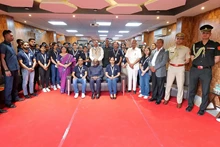
Silk is one of the most demanding textile and fabric products since ancient times. It is originated in China. Silkworm or Bombyx Mori (Scientific Name) is responsible for the production of silk. In China it is cultivated from B.C. and now has spread throughout the world by merchandising.
Basically Silk is a natural fiber protein and produced by the insects like moths or caterpillars. The protein present in Silk is fibroin. Silk fiber has a triangular prism-like structure which allows silk cloth for the refraction of incoming light at different angles then it produces different colors. In India there are mainly 4 types of silk is produced namely Mulberry silk, Tasar silk, Muga silk and Eri silk.
How silk is made?
Breeding silkworms: - Healthy Female silk moths can lay around 300 – 500 eggs at any one time. These eggs eventually hatch to form silkworms, which are incubated in a controlled environment until they hatch into larvae (caterpillars).
Feeding the Larvae
The silkworms feed only on the leaves of the mulberry tree. The mulberry leaves are finely chopped and fed to the voracious silkworms every few hours for 20 to 35 days. During this period the worms increase in size to about 3.5 inches (8.9 cm). They also shed their skin, or molt four times and change from gray to a translucent pinkish color.
Spinning the cocoon
Attached to a secure frame, the silkworm will begin spinning its silk cocoon by rotating its body in a figure-8 movement around 300,000 times – a process which takes around 3 to 8 days. Each silkworm produces one single strand of silk which measures around 100 meters long and is held together by a type of natural gum called sericin.

Thread extraction
Once the silkworms have spun their cocoon, they will eventually enclose themselves inside and then it’s time to extract the silk threads. The cocoons are placed into boiling water in order to soften and dissolve the gum that is holding the cocoon together. This is a crucial step in the silk production process as it ensures that there is no damage to the continuity of each thread. Each thread is then carefully reeled from the cocoon in individual long threads, which are then wound on a reel. Some of the sericin may still remain on the threads to protect the fibers during processing, but this is usually washed out with soap and boiling water.
Dyeing
The silk threads have been washed and degummed. They will be bleached and dried before the dyeing process begins. The threads will be soaked together in bundles, inside a pot of hot indigo leaves and water. This process will occur multiple times over a span of days to ensure proper color tone and quality.
Spinning
The process of spinning essentially unwinds the dyed fibers on to a bobbin, so that they lay flat ready for the weaving process. This can be done in many different ways from hand-spinning to ring-spinning and mule spinning.
Weaving
Weaving is the process in which the final piece of silk comes together. There are many different ways in which silk can be woven – satin weave, plain weave and open weave are most common, and the finish of the silk will depend on the type of weave. Generally, weaving involves interlacing two sets of threads so that they lock around each other and create a strong, uniform piece of fabric. The threads will be woven at right angles to each other, and the two different angles are called a warp and a weft. The warp will run up and down the fabric, while the weft runs across it.
Thus, in this way silk is produced.








